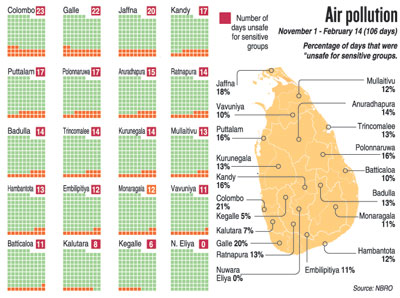News
Sri Lanka chokes on dirty air from neighbours, but pollution is also at home
View(s):By Mimi Alphonsus
The greyish white veil covering most of Sri Lanka in recent months is not mist. It’s air pollution. Bits of diesel, wood, water, soil, sulfate, metals and other tiny inhalable particles blow through the island, trapping people indoors and suffocating those who must brave the haze. Sri Lanka has experienced the highest levels of air pollution since 2022 in the last three months.
Air pollution is seasonal, with the October to March North-East monsoon bringing with it pollution from other parts of Asia. In Colombo, 1/5th of all days between November 1 and February 14 were considered to be “unhealthy for sensitive groups”, according to the government’s air pollution classifications (these classifications are less stringent than the WHO’s. See box for more details).
Children, pregnant mothers, seniors, and those suffering from respiratory diseases fall into the “sensitive groups” category. With consistent exposure they run the risk of asthma, reduced lung function, respiratory infections, low birth weight, chronic bronchitis, and premature death. In Jaffna there were also two days of pollution considered “unhealthy for all groups’’.
While there is no updated or precise data about disease levels directly attributable to air pollution, respiratory disease in general has been on the rise and the Ministry of Health has warned about the role pollution has to play. WHO estimated from 2012 indicate that 1000 deaths in
Sri Lanka were directly caused by outdoor air pollution.

Sri Lankan law requires minimum air quality standards via regulations under the National Environment Act. According to the gazette particulate matter smaller than 2.5 micrometres should not exceed 50 per cubic metre over 24 hours. However, in the last three months, it did on several occasions in all provinces except Nuwara Eliya. The regulations do not prescribe any recourse in the event that the limits are exceeded.
South Asia is at the center of the air pollution crisis, with India, Pakistan, and Bangladesh topping the list of the most polluted countries in the world. Air pollution, however, does not respect state or national boundaries. According to the World Bank, in most cities in South Asia about 50% of pollution comes from outside, usually another state, and in the Sri Lankan island’s case, other countries. The Central Environmental Authority told the Sunday Times that air pollution also has an impact on climate change and weather patterns and that international and regional cooperation is essential to mitigate it.
However, domestic pollution, too, has a part to play. According to the same report, while a sizeable chunk comes from other countries, much of Colombo’s air pollution comes from within — vehicle exhaust, industrial emissions, agricultural burning, and domestic pollution from burning cooking fuel or garbage.
According to H. D. S. Premasiri, coordinator, air quality, at the National Building Research Organization (NBRO), which is responsible for monitoring air quality, vehicle emissions account for about 60% of urban air pollution. Indeed, hourly air quality analysis of sensors in Colombo shows that while air quality may be “moderate” on average, it often tips into the “unhealthy for sensitive groups” category during traffic hours, when thousands of public transport users are on the road and exposed.
Mr Premasiri says that vehicle emissions programmes and recent regulations on industrial plants (Stationary Source Emission standards regulation) have helped control air pollution levels. “Now we are turning to the local authority levels to bring down domestic pollution and garbage burning.”
Dr. Ranil Dhammapala senior meteorologist at South Coast Air Quality Management District, California, said that Sri Lanka must raise awareness on the issue so that local air pollution can be controlled during high transboundary flows in October to March. “For example we need to clamp down on backyard burning during those days when pollution is coming from other countries, and insist that it only take place during the hot hours of the day when atmospheric dispersion is best.” To effectively enforce this Mr Dhammapala suggests forewarning people about seasonal haze and including air pollution information into TV weather reports.
Besides health, air pollution also affects economic activity. Construction workers give early warnings of what’s to come as air quality worsens in South Asia. “I know that the government issued a warning some days ago about being outside,” said construction worker Thushara Perera, 53.,“We did not stop working but we did decide to do more interior work on the days when the pollution was very bad.”
According to the World Bank, globally around 1.2 billion work days are lost each year due to air pollution.
Tourism too is likely to be impacted. Chalana Perera, a regenerative tourism specialist who has advised the Sri Lanka Tourism Development Authority and private sector, warns that certain travellers increasingly consider air pollution as a factor when making travel decisions. “Currently, some developed countries advise their citizens about petty-crime, violence, and sanitation levels at their travel destinations,” he said, “in the future there will undoubtedly be advisories on air quality, too.”
Both the Australian and US governments already alert their citizens to air quality while travelling. In New Delhi, where tourism has declined due to air pollution, hotels have started advertising their air filtration systems in a bid to attract guests. Europe and Australia have started running tourism campaigns centered on fresh air.
“India has large booming industries so a decline in inbound tourism wouldn’t affect its economy as severely as it would Sri Lanka,” explained Mr. Perera. He believes that just as the region’s air quality is a growing problem, it can also be an opportunity for Sri Lanka to stand out in tourism if it “acts now to deliver clever, proactive solutions.”
The best way to say that you found the home of your dreams is by finding it on Hitad.lk. We have listings for apartments for sale or rent in Sri Lanka, no matter what locale you're looking for! Whether you live in Colombo, Galle, Kandy, Matara, Jaffna and more - we've got them all!

